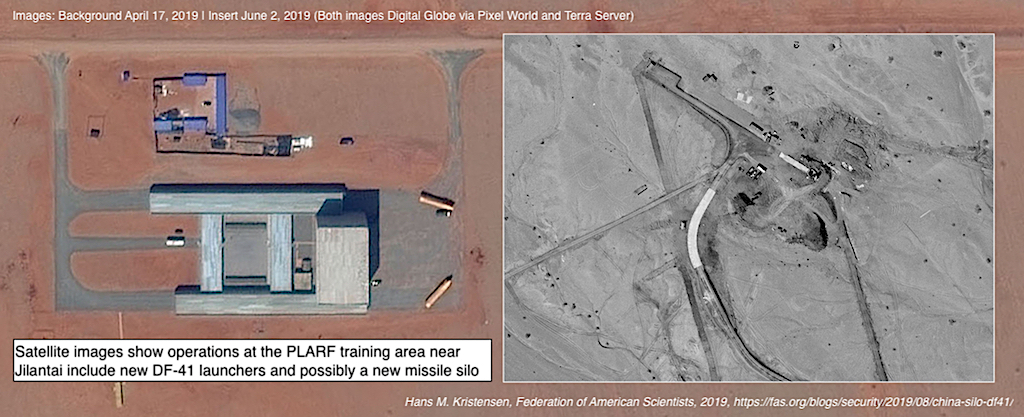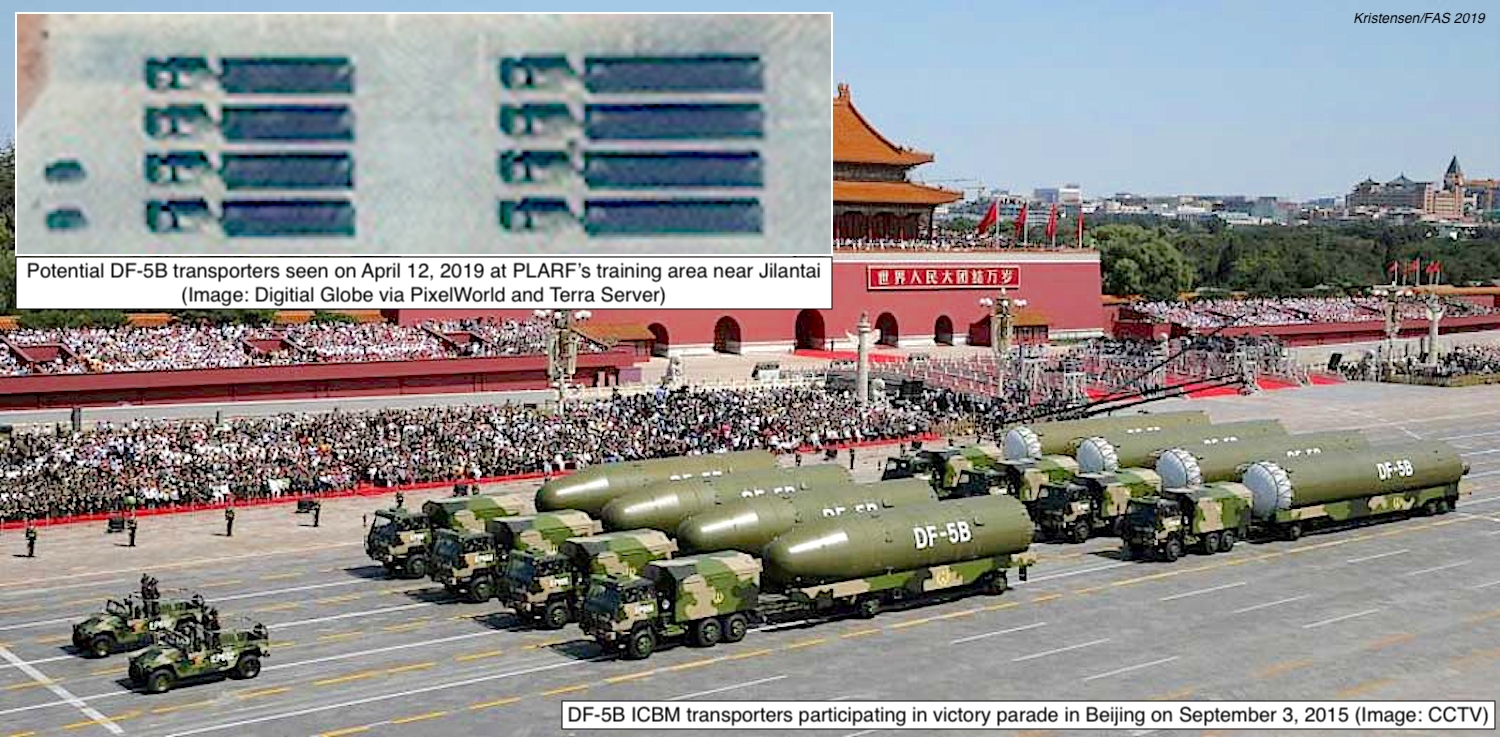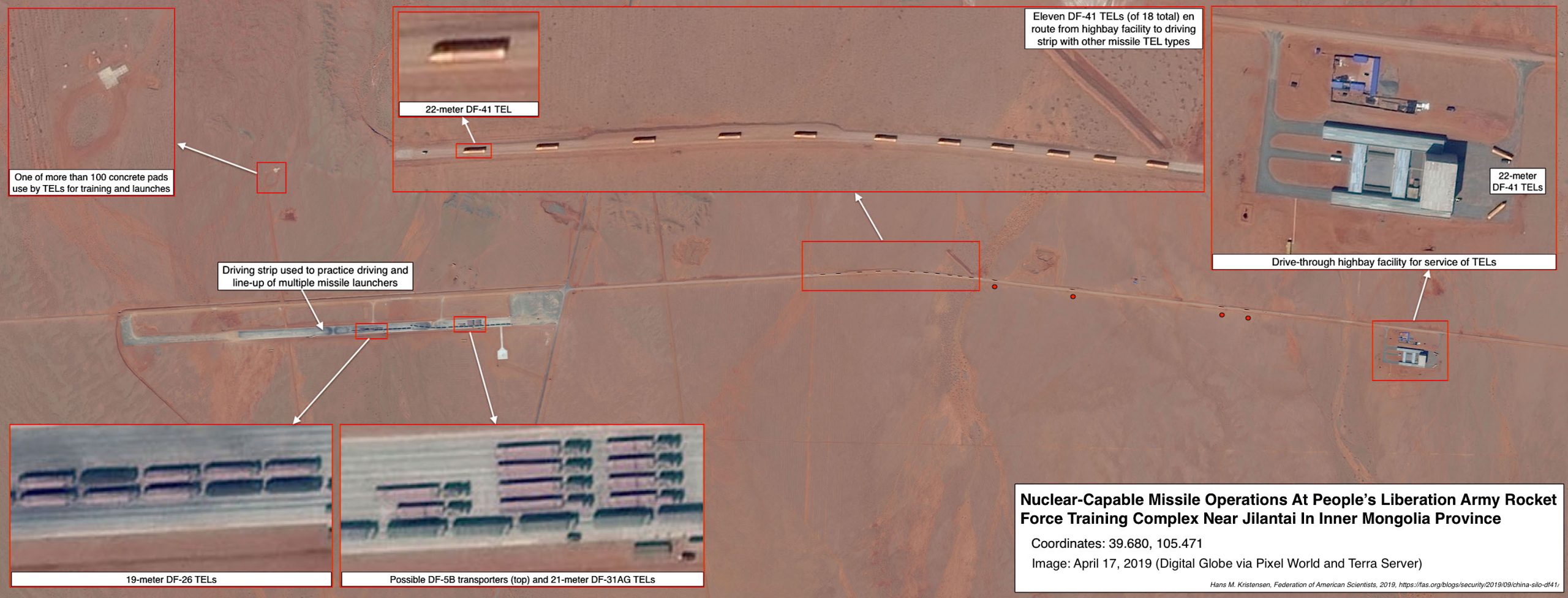
New Missile Silo And DF-41 Launchers Seen In Chinese Nuclear Missile Training Area
Newly acquired satellite photos acquired from Digital Globe (Maxar) show that the People’s Liberation Army Rocket Force (PLARF) is building what appears to be a new type of missile silo in the missile training area near Jilantai, possibly for use by a new ICBM.
The photos also show that 18 road-mobile launchers of the long-awaited DF-41 ICBM were training in the area in April-May 2019 together with launchers for the DF-31AG ICBM, possibly the DF-5B ICBM, the DF-26 IRBM, and the DF-21 MRBM.
Altogether, more than 72 missile launchers can be seen operating together.
China is in the middle of a significant modernization of its nuclear weapons arsenal and the Jilantai training area, which has been constructed since 2014, appears to play an important part in that modernization effort.
A New Type of Missile Silo?
The most surprising new development in the training area is the construction of what may be a new type of missile silo. I want to emphasize that there is no official confirmation the structure is a silo, but it strongly resembles one. If so, it is potentially possible it could be part of a Chinese effort to develop the option to deploy some of its new solid-fuel road-mobile ICBMs – possible the DF-41 – in silos. According to the 2019 Pentagon report on Chinese military developments, “China appears to be considering additional DF-41 launch options, including rail-mobile and silo basing.”
Construction of the silo began in June 2018. Initially, a roof was built over it to conceal details, but in May 2019 the roof was removed exposing the silo to satellite photography (see image below).
The layout of the Jilantai silo is very different from the silos seen at Wuzhai. Those silos, which are thought to be similar to about 20 operational silos hidden in the mountains of the Henan and Hunan provinces for use by the liquid-fuel DF-5A/B ICBMs, consist of a rectangular retractable lid covering the silo on a concrete pad. And they have large exhaust vents to protect the DF-5’s liquid fuel from the launch heat.
Instead, the Jilantai silo looks more like Russian ICBM silos. It is not yet complete but so far consists of what appears to be a 180-meter line-up path and a 30-meter missile loader pad next to the silo. The precise silo diameter is difficult to measure given the image resolution but appears to be 5-6 meters, which is smaller than the 8-9 meter diameter silos at Wuzhai. Moreover, the absence of exhaust vents hints the Jilantai silo might be intended for solid-fuel missiles.
The new silo design would offer a more efficient (and safe) missile loading. At the DF-5 silos, missiles are loaded by a crane, which hoists each stage off its transporter and lowers it into the silo. It is a cumbersome and lengthy procedure. Moreover, the DF-5 is propelled by liquid fuel that is stored separately and must be loaded before the missile can be launched. With the Jilantai silo design, however, the solid-fuel missile presumably would be brought in on a loader that backs up to the edge of the silo, elevates the missile, and lowers it into the silo in one piece (warhead payload is probably added later).
If the structure seen at Jilantai indeed is a new silo, it presumably would only be used for training. If the design is successful, it would likely be followed in the future by the construction of similar silos in China’s ICBM basing areas for use by operational missiles.
Extensive Missile Training
The Jilantai missile training area, which has been constructed since 2014 and is located in the south-western part of the Inner Mongolia province approximately 930 kilometers (578 miles) west of Beijing, has undergone significant changes since I described it in January. The central technical facilities continue to expand, TEL drive-through facilities are being added, and road-mobile launchers for China’s newest nuclear-capable ballistic missiles are seen more or less constantly training in the area.
This includes the new DF-41 ICBM that may be in the final phase before starting to deploy to operational PLARF brigades. The new DF-31AG ICBM is also training at Jilantai, as is the new DF-26 IRBM and the DF-21 MRBM (see image below).

Five types of ballistic missile can be seen operating in PLARF’s training area near Jilantai. Click on image to view full size.
All these systems are solid-fuel missiles on road-mobile launchers. But it is also possible – although at this point unconfirmed – that missile systems seen training at Jilantai include transporters for the silo-based DF-5B ICBM. This is a large silo-based missile that would not be able to launch from mobile launchers, but the images show unique two-part, truck-pulled trailers that resemble the DF-5B transports that were displayed at the Beijing parade in 2015 (see image below).

Vehicles operating at PLARF’s training center near Jilantai resemble DF-5B transporters shown in 2015 parade (click on image to view full size)
It must be underscored that there is no confirmation the trailers are for the DF-5B. In one photo some of the trailers are longer and it is unclear why DF-5B transporters would be training at Jilantai given there are no DF-5B silos in the area. If the towed trailers are not DF-5Bs, they could potentially be transporters of reload missile for the road-mobile launchers seen on the satellite photos.
The DF-41 ICBM
The satellite images indicate that the DF-41 TELs started training at Jilantai in April 2019 shortly after a new TEL drive-through highbay facility was completed (a second is under construction further to the north). There appear to be 18 DF-41 launchers. In one photo from April 17, 2019, for example, a column of 15 DF-41s can be seen making its way from the new drive-through facility (two additional DF-41s can still be seen at the facility and the 18th is probably still inside) to a parade strip to join an assembly of 18 DF-31AGs, 18 DF-26s, and 5 (possibly) DF-5B transporters.

Eighteen DF-41 TELs were operating at PLARF’s training site in April this year. Click on image to view full size.
The DF-41 has been in development for a very long time. The Pentagon’s annual report on Chinese military developments first mentioned the missile in 1997 and sensational news articles have claimed it has been operational for years. The DF-41 was widely expected to be displayed at the 2015 military parade in Beijing, but that didn’t happen. Nor was it displayed at the PLA’s anniversary parade in 2017.
The DF-41 training at Jilantai with the other launchers is probably part of the formal integration of the new missile into PLAFRF service, more than two decades after development began. It seems likely that the DF-41 will appear at the military parade in Beijing on October 1st. Indeed, two months after the training occurred at Jilantai, 18 DF-41 launchers (potentially the same 18) could be seen on a satellite photo of a military facility in Yangfang about 35 kilometers (22 miles) northwest of Beijing apparently getting ready for the October parade. The image first made its way onto the Internet on August 9th, when it was posted by the Twitter user @Oedosoldier. The image carried the user’s logo but it was a screenshot from a Digital Globe image on TerraServer dated July 4, 2019.
Chinese Nuclear Missile Outlook
The highly visible display and clustering of more than 72 missile launchers at Jilantai in April and May indicate the PLARF wants them to be seen and is keenly aware that satellites are watching overhead. This is Beijing’s way of telling the world that it has a capable and survivable nuclear deterrent.
Once they become operational, the 18 DF-41s seen on the satellite photos will probably form two or three brigades and join the existing force of 65-90 DF-5A/B, DF-31/A/AG, and DF-4 ICBMs.
Despite the visible display, there is considerable uncertainty about the future development of the Chinese nuclear arsenal, not least how many missiles China plans to deploy. It seems possible the DF-41 over time might replace one or more of the older ICBMs. It is potentially also possible that the DF-31AG will replace the older DF-31/A trailer launchers (the DF-31 is notably absent from the Jilantai images). And the old DF-4 seems likely to be retired in the near future.
The US Defense Intelligence Agency (DIA) stated in May this year that, “Over the next decade, China is likely to at least double the size of its nuclear stockpile…” Part of that projection hinges on the DF-41 adding MIRV capability to the solid-fuel road-mobile missiles for the first time (the DF-5B is already equipped with MIRV).
Whether DIA’s projection comes true remains to be seen; the agency has been notoriously bad about Chinese nuclear warhead projections in the past. At this point, the Chinese arsenal is estimated to include roughly 290 warheads, a fraction of the U.S. and Russian nuclear arsenals. To put things in perspective, all the launchers seen on the satellite photos make up less than half of the number of launchers in one of the three US ICBM wings.
Nonetheless, China is modernizing and increasing its nuclear arsenal. And the activities captured by commercial satellites at the PLARF’s training area west of Jilantai – operations of new DF-41 and DF-31AG ICBMs, the new dual-capable DF-26 IRBM, and the construction of what might be a new type of missile silo – are visual reminders of the important developments currently underway in China’s nuclear posture.
Additional background:
FAS Nuclear Notebook: Chinese nuclear forces, 2019
This publication was made possible by generous contributions from the Carnegie Corporation of New York, the John D. and Catherine T. MacArthur Foundation, the New Land Foundation, the Ploughshares Fund, and the Prospect Hill Foundation. The statements made and views expressed are solely the responsibility of the authors.
The FY2026 National Defense Authorization Act (NDAA) paints a picture of a Congress that is working to both protect and accelerate nuclear modernization programs while simultaneously lacking trust in the Pentagon and the Department of Energy to execute them.
While advanced Chinese language proficiency and cultural familiarity remain irreplaceable skills, they are neither necessary nor sufficient for successful open-source analysis on China’s nuclear forces.
Satellite imagery has long served as a tool for observing on-the-ground activity worldwide, and offers especially valuable insights into the operation, development, and physical features related to nuclear technology.
This report outlines a framework relying on “Cooperative Technical Means” for effective arms control verification based on remote sensing, avoiding on-site inspections but maintaining a level of transparency that allows for immediate detection of changes in nuclear posture or a significant build-up above agreed limits.

